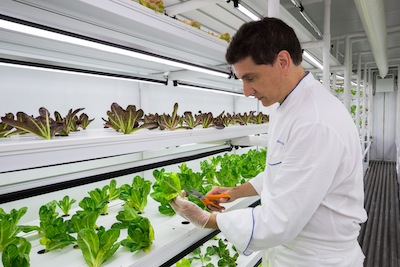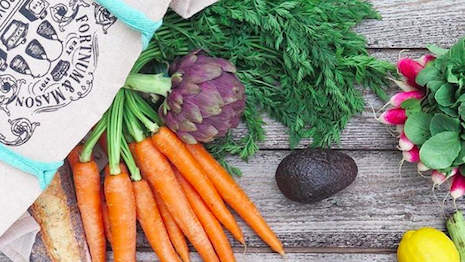With a penchant for experiences, millennials now spend more on “Insta-worthy” meals than on designer handbags and shoes, according to a report by Havas Worldwide.
While the latest it-bag or on-trend footwear may have once been a subject of conversation and a clear marker of status, gastronomy is becoming a sort of conversational currency driven by social media and the embrace of experiential activities. As personal expression moves toward what experiences have been had, rather than what material goods have been bought, luxury brands will have to retool strategies in a culinary-rooted direction to account for consumer behavior.
“Many consider spending $100 on a logo designer t-shirt senseless and would rather invest in an exceptionally made, quality treat,” said Wanda Pogue, chief strategy officer at Saatchi & Saatchi New York. “Food ranks high for them. From a ‘grammed brunch with friends to a Cronut that they waited an hour in line for, they get a great story to share and an emotional payoff that is as big, if not bigger than what traditional luxury goods provide — but without the big financial investment.
“Just as people have always sought to express who they are through the clothes they wear and possessions they own, Generation Z and millennials now explore and express their identity through the foods they eat,” she said. “Food has become just another platform for self expression for both consumers and companies — a way to express creativity and even their sense of design. As a result, luxury fashion companies such as Kith (with their in-store Cereal Bar) are now extending into the food category.”
Havas Worldwide’s “Eater’s Digest: The Food of the Future” surveyed more than 11,000 men and women. Marketing agency Saatchi & Saatchi New York has come to similar conclusions outlined below along with findings from Havas Worldwide’s survey.
Dining for the likes
In the past, personal expression came from the goods purchased, such as apparel and accessories. However, this concept is evolving as millennial and Generation Z consumers are more likely to express themselves through the foods they eat.
The rise of gluten-free, veganism and paleo diets is only one aspect of self-identification through foods. Even weekly outings for picturesque brunches have become a status marker among this segment of the population.
This change in behavior also plays to the demographics’ affinity for creativity and sense of design, accelerated in part by social media.
“The foodie trend took hold before social media, but it most definitely has been accelerated by all the new platforms—from Instagram and Facebook to OpenTable and Yelp—that have made it so easy to connect with fellow food lovers, discover new places and things to eat, and establish a record of one’s food adventures,” said Matt Weiss, global chief marketing officer and global chief revenue officer at Havas Worldwide.
“We’ve all heard about restaurants being redesigned to be more ‘Instagram-friendly’ and even establishments that offer discounts for good reviews and social media ‘likes.’
“The smartest food retailers, in my view, aren’t resorting to gimmicks, but instead are finding meaningful ways to connect with current and potential customers online,” he said. “That means being part of the conversation, communicating with an engaging personality, responding quickly (and appropriately) to negative reviews/posts and offering ‘extras’ such as recipes, sourcing information and educational articles, videos or podcasts.”
We know from our study that most millennials around the globe consider themselves foodies. Restaurants need to respect that—both on-site and via social media. And they need to keep upping their game to ensure their offering never goes stale.
Per Havas Worldwide’s Eater’s Digest: The Food of the Future report, a majority of millennials and almost two-thirds of prosumers identified as foodies. Both consumer groups also consider dining out in restaurants as a social activity, and even something as routine as grocery shopping is counted as a favorite chore.
Due to the rise of experiential interests, gastronomy has proven attractive because of the endless opportunities for experimentation. With seemingly infinite dining options, easily sourced recipes and access to a bevy of high-quality ingredients, especially for urbanites, culinary experiences are alluring, either at home or an eatery.
In its report, Havas Worldwide found that seven in 10 millennials and eight in 10 prosumers enjoy experimenting with new flavors and ingredients.
Likewise, 61 percent of prosumers have an interest in tasting “exotic” foods, and 65 percent feel they are more adventurous eaters than they had been in the past. Millennials follow at 58 percent and 61 percent, respectively.
An interest in gastronomy has also reestablished eating as a social function, not a harried necessity. For many, time has become the one last true luxury commodity and enjoying a meal with friends and family, as part of a healthy lifestyle, is asserting itself into this ideology.
Eighty-nine percent of prosumers and 80 percent of millennials feel that taking time to enjoy a meal is essential to good health. Although the majority of those surveyed feel their meals are rushed, there is also strong admiration of cultures where it is the norm to take longer lunch breaks to eat a good meal in the company of others.
However, organic, locally sourced, healthy foods are correlating more with one’s health than hedonism, Havas Worldwide found.
The hospitality industry, for example, has tapped into this aspect of the food as a luxury trend.
For example, The Ritz-Carlton Resort of Naples, FL, increased its use of locally sourced produce by building its own “grow house” in a repurposed shipping container.

Ritz-Carlton chef attending the Naples, FL grow house
The on-site Grow House was the first of its kind in a resort setting and has aided the hotel’s culinary staff in preparing meals for guests using fresh and hyper-local produce (see story).
“The rise of foodie culture in recent years fits perfectly into this new notion of luxury,” Havas Worldwide’s Mr. Weiss said. “Young people, especially, take pride in their embrace of good food, their experimentation with new cuisines, ingredients and flavor combinations and their mindfulness with regard to sourcing, sustainable production techniques, Fair Trade and the like.
“So just as much as fashion or music, food has become a way for young people to express who they are, what matters to them and how they wish to be perceived,” he said. “For luxury brands, this new mindset requires an approach that emphasizes connoisseurship (e.g., tea classifications, artisanal techniques), conversational currency (unique experiences they’ll want to talk about) and connectedness (to specific cultures, eras, values, etc.).”
What’s on the menu?
As millennials and Generation Z consumers continue to view gastronomy experiences as validation of status and conversational currency over social media, luxury brands must tap into the food trend to gain attention from these demographics.
Branded, in-store and limited-time culinary happenings have emerged as one way to ensure awareness.
For example, The Peninsula Bangkok offered consumers a culinary exploration of Tiffany & Co.’s iconic blue for the month of May.
The hotel’s Tiffany Afternoon Tea included handcrafted delicacies that are inspired by the brand’s glamorous image. The menu included New York-style cheesecake in the shape of the jeweler’s gift boxes, blueberry cupcakes, a pastrami sandwich on a bagel and a coconut buttercream macaron made in blue with silver sugar to resemble a wedding ring (see story).

Tiffany & Co. branded tea at The Peninsula Bangkok
High-end department stores also have well-rounded culinary offerings that play off desired ingredients. For instance, British retailer Harrods updated its high-end culinary offerings in 2015 with a truffle-themed restaurant on the department store’s lower ground floor.
Opened since April 2015, Harrods invited Italian truffle lounge Tartufi & Friends to craft a menu entirely devoted to earthy truffles including appetizers, main courses, dessert and cocktails within the store. With outposts in Milan and Rome, Tartufi & Friends’ experience appeals to truffle lovers interested in sampling the delicacy in a range of innovative ways (see story).
Monobrand stores have also embraced in-store dining with Giorgio Armani, Ralph Lauren and Burberry all establishing culinary options. Ensuring a branding experience, consumers can stop in just for a bite to eat or include dining in-store as part of their overall time spent shopping the brand.
After establishing a branded coffee shop in its Fifth Avenue flagship in 2014, U.S. lifestyle brand Ralph Lauren continued to round out its culinary offerings with the opening of a its first restaurant in New York.

A burger served at Ralph Lauren’s The Polo Bar
Ralph Lauren’s The Polo Bar is housed at 1 East 55th Street, around the corner from the entrance of the brand’s Ralph Lauren Polo flagship on Fifth Avenue. The Polo Bar offers a classic, yet refined, setting for food and drinks while paying homage to “the distinguished sporting lifestyle long synonymous with the Ralph Lauren brand” (see story).
Per Havas Worldwide’s research on the subject, branded restaurant and cafe ventures put forth by luxury brands work to cull millennial engagement.
“We’re seeing lots of lower- and mid-range food retailers revamping their menus and restaurant décor to appeal to this new generation of foodies,” Havas Worldwide’s Mr. Weiss said.
“There’s no reason luxury brands can’t be successful in this space, but it’s essential that their cafes and restaurants reflect what millennial foodies want: shared experiences, a chance to ‘discover’ new ingredients and flavor combinations and some sort of entertainment factor. The latter doesn’t mean a piano in the corner; it means things such as in-sight food prep and opportunities for knowledge gathering and customization,” he said.
“Millennials also want to feel that they’re making smart, values-centric food choices, so they’re less about food-as-art (e.g., molecular gastronomy, the minimalism of Nouvelle Cuisine) and more about food-as-values (e.g., slow food, heirloom vegetables, farm-to-table). Playing up the luxury retailers’ authentic roots will win over more millennial diners than would displays of opulence.”
from Travel and hospitality – Luxury Daily https://www.luxurydaily.com/gastronomy-to-replace-material-goods-as-status-marker-conversational-currency/
via Your #1 Source to Finding Luxury & Designer Goods, Handbags & Clothes at or Below Wholesale: Click Here.



No comments:
Post a Comment